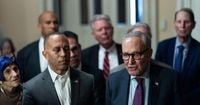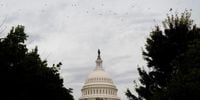With the clock ticking toward a midnight shutdown on September 30, Washington is once again bracing for a high-stakes standoff over government funding. President Donald Trump and Republican leaders are set to meet top Democrats on Monday, September 29, 2025, in a last-ditch effort to avert a shutdown that would furlough hundreds of thousands of federal workers and disrupt public services nationwide. The mood in the capital is tense, with both sides digging in on core issues—most notably, health care and immigration—while the fate of the federal government hangs in the balance.
President Trump, now in his second term, has left his mark on both the White House and the nation’s political landscape. Over the weekend, he took to social media to tout his redecorating efforts, declaring, “Some of the highest quality 24 Karat Gold used in the Oval Office and Cabinet Room of the White House. Foreign Leaders, and everyone else, ‘freak out’ when they see the quality and beauty.” He went on to call it the “Best Oval Office ever, in terms of success and look!!!” But as ornate as the surroundings may be, the real drama is unfolding over the future of government operations.
The looming shutdown is the result of a bitter impasse between President Trump and congressional Democrats. According to CBS News, Trump warned on Sunday that a shutdown is likely unless Democrats back down from their negotiating position. “I just don’t know how we are going to solve this issue,” he said in a phone interview, expressing confidence that the American people would side with him if the government closes its doors. He accused Democrats of being uninterested in tackling “fraud, waste and abuse” and insisted that any deal must include stricter immigration measures, particularly to prevent undocumented migrants from accessing public benefits.
The Democratic response has been swift and pointed. House Minority Leader Hakeem Jeffries told MSNBC, “Donald Trump knows, or at least I think he knows, that current federal law prohibits using taxpayer dollars for undocumented immigrants in connection with their health care. And no one is trying to change or reverse that law.” Jeffries emphasized that Democrats are “fighting to protect the healthcare of everyday Americans in the midst of this Republican-caused crisis that is devastating hospitals and nursing homes and community-based health clinics.”
At the core of the dispute is the extension of enhanced Affordable Care Act (ACA) subsidies, a key Democratic demand. Democrats want to make these subsidies permanent, roll back Medicaid cuts in Trump’s “big, beautiful bill,” and restore funding for public broadcasters. Republicans, meanwhile, have passed a continuing resolution in the House to keep the government open until November 21, but without the health care provisions Democrats insist are non-negotiable. The Senate, which requires 60 votes to advance most legislation, has so far failed to move either party’s proposal forward.
Senate Majority Leader John Thune, echoing Trump, told NBC’s “Meet the Press” that “it’s totally up to the Democrats” whether the government shuts down, pointing to a House-passed bill awaiting action in the Senate. “We need eight Democrats to pass it through the Senate,” Thune said, framing the impasse as a Democratic responsibility. House Speaker Mike Johnson struck a similar note, telling CNN, “He [Trump] wants to bring in the leaders, to come in and act like leaders and do the right thing for the American people.” Johnson said the president’s priority is preventing disruption to military pay and accused Senate Minority Leader Chuck Schumer and other Democrats of leveraging the standoff for partisan gain.
Yet Democrats remain united on their health care demands. Senator Amy Klobuchar stated on CBS’s “Face the Nation,” “Democrats are united in pushing” on the health-care issue, adding that “the Republicans have created a health care crisis.” Virginia Senator Tim Kaine criticized Trump for not negotiating across the aisle, contrasting the current approach with President Biden’s willingness to meet with congressional leaders from both parties. “The only thing about the President’s threat to fire more people is he’s already doing it, and instead of threatening he should just be meeting to negotiate,” Kaine said.
Not all Democrats are in lockstep, though. Senator John Fetterman of Pennsylvania told Fox News, “I have a hard rule. Don’t shut the government down. It’s wrong,” adding, “It is always, always wrong to shut our government down. That is a core responsibility. I’m always going to vote against those things.” Fetterman has previously worked with Republicans to prevent funding lapses, underscoring the costs and chaos associated with shutdowns.
Republicans, for their part, are not entirely unified either. Kentucky Senator Rand Paul, speaking on CBS’s “Face the Nation,” criticized both parties’ spending plans for adding to the national debt. “The Republican proposal adds about $2 trillion in debt over the next year, so it’ll be short $2 trillion, so I oppose the Republican plan because it adds debt,” Paul said. “The Democrat plan would add $3 trillion in debt. So really, both plans are laden with deficit spending.” Paul has advocated for a Government Shutdown Prevention Act, which would gradually reduce government funding rather than trigger a full shutdown, though the measure failed in the Senate.
Meanwhile, the practical implications of a shutdown are coming into focus. According to CNN, the Department of Defense’s contingency plan will retain nearly 224,000 of over 741,000 civilian employees, along with nearly 2.1 million military personnel, focusing on priorities such as border security, Middle East operations, and the Golden Dome missile defense system. The Department of Homeland Security will furlough only 14,000 of its nearly 272,000 employees, keeping most Customs and Border Patrol, ICE, TSA, and FEMA staff on the job. Essential services like counter-terrorism, disaster relief, and immigration enforcement will continue, but many nonessential employees face unpaid furloughs.
Beyond the shutdown, President Trump is making headlines on other fronts. He announced plans to send troops to Portland, Oregon, to guard Immigration and Customs Enforcement (ICE) facilities, citing ongoing protests and what he describes as a crackdown on crime in American cities. This move has drawn criticism from local leaders and added fuel to the already heated debate over federal intervention in local law enforcement.
Internationally, Trump is expressing optimism about a potential deal to end the war in Gaza, with Israeli Prime Minister Benjamin Netanyahu set to visit the White House. Trump has promoted a 21-point peace plan, claiming, “ALL ARE ON BOARD FOR SOMETHING SPECIAL, FIRST TIME EVER. WE WILL GET IT DONE!!!” The reaction in Israel is mixed, with far-right ministers opposing any deal short of Hamas’s total defeat, while other coalition partners and opposition leaders express support for a ceasefire and hostage release.
As the Senate returns from recess and the White House prepares for a critical meeting, the stakes could hardly be higher. Both parties are wagering that the public will blame the other side if the government shutters its doors. With little time left, the only certainty is that the next few days will test the resolve—and the willingness to compromise—of Washington’s most powerful players.



